Choosing the right wood for your kitchen countertops can feel overwhelming. With so many options available, how do you know which one will work for your lifestyle and budget?
You’re probably wondering about durability, maintenance, and costs. Maybe you’re concerned about scratches from daily cooking. Or perhaps you want something that looks great but won’t break the bank.
We get it. Your countertops take a beating every single day. From hot pots to knife work, they need to handle whatever you throw at them.
In this guide, we’ll walk you through 7 proven wood types that real homeowners love. You’ll learn which woods resist scratches and dents best, realistic maintenance requirements, honest cost comparisons, and what works for different kitchen styles.
No fluff, no sales pitches. Just straightforward information from people who understand that your kitchen needs to work as hard as you do.
By the end, you’ll know exactly which wood type fits your needs, budget, and lifestyle.
Top 7 Wood Types for Countertops
Let me walk you through the wood types that work in real kitchens. I’ve seen homeowners make great choices and terrible mistakes. Here’s what you need to know.
1. Maple
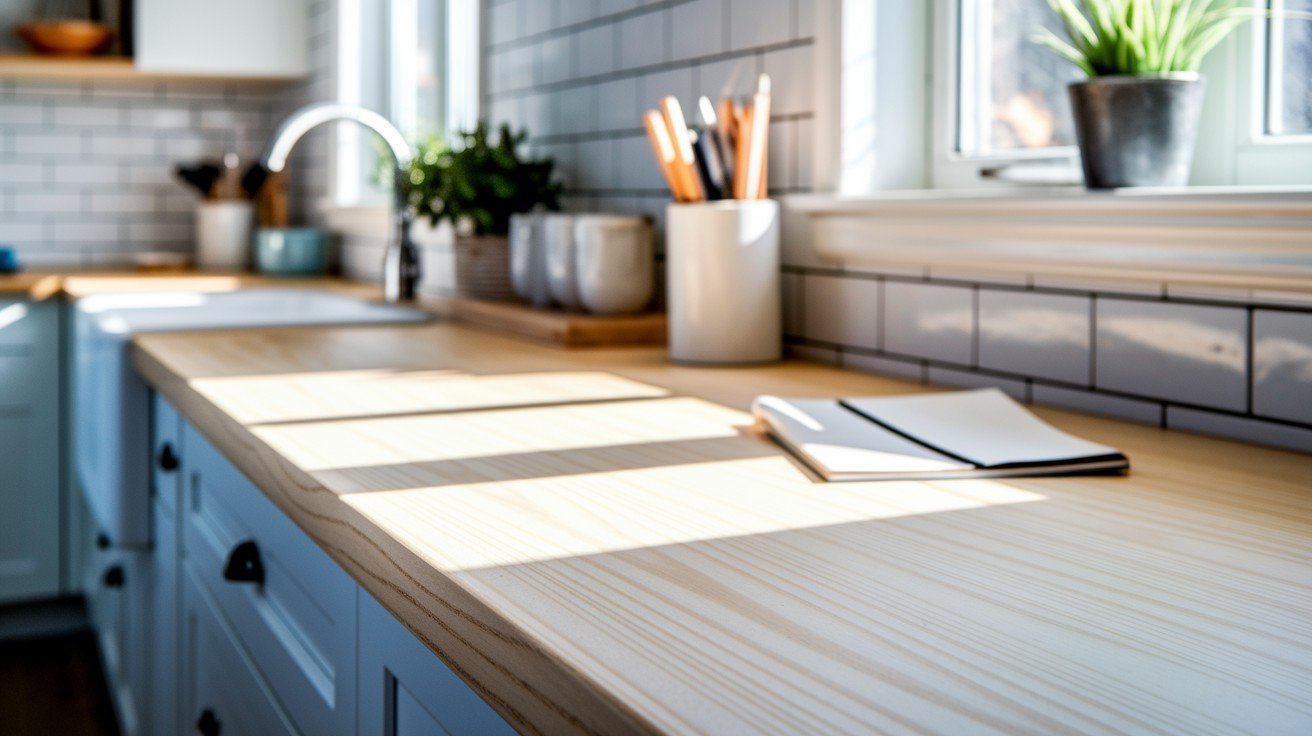
Maple is the safe bet that rarely disappoints. Think of it as the reliable friend who always shows up when you need them.
Appearance: Light, creamy color with fine, even grain. It’s clean-looking without being boring. The grain is subtle, so it won’t fight with your cabinet colors or backsplash.
Durability: Superior scratch and dent resistance. I’ve seen maple counters in busy family kitchens that still look great after 10 years. Your kids can do homework on these without you worrying about every pencil mark.
Cost: $50-$100 per square foot. Mid-range pricing that gives you good value.
Best For: Brightening spaces, versatile design compatibility. Perfect if you change your mind about decor often. Maple adapts to whatever style you throw at it.
Care: Periodic sealing, avoid direct sunlight. That big window over your sink? It might fade over time. Not a dealbreaker, just something to consider.
2. Cherry
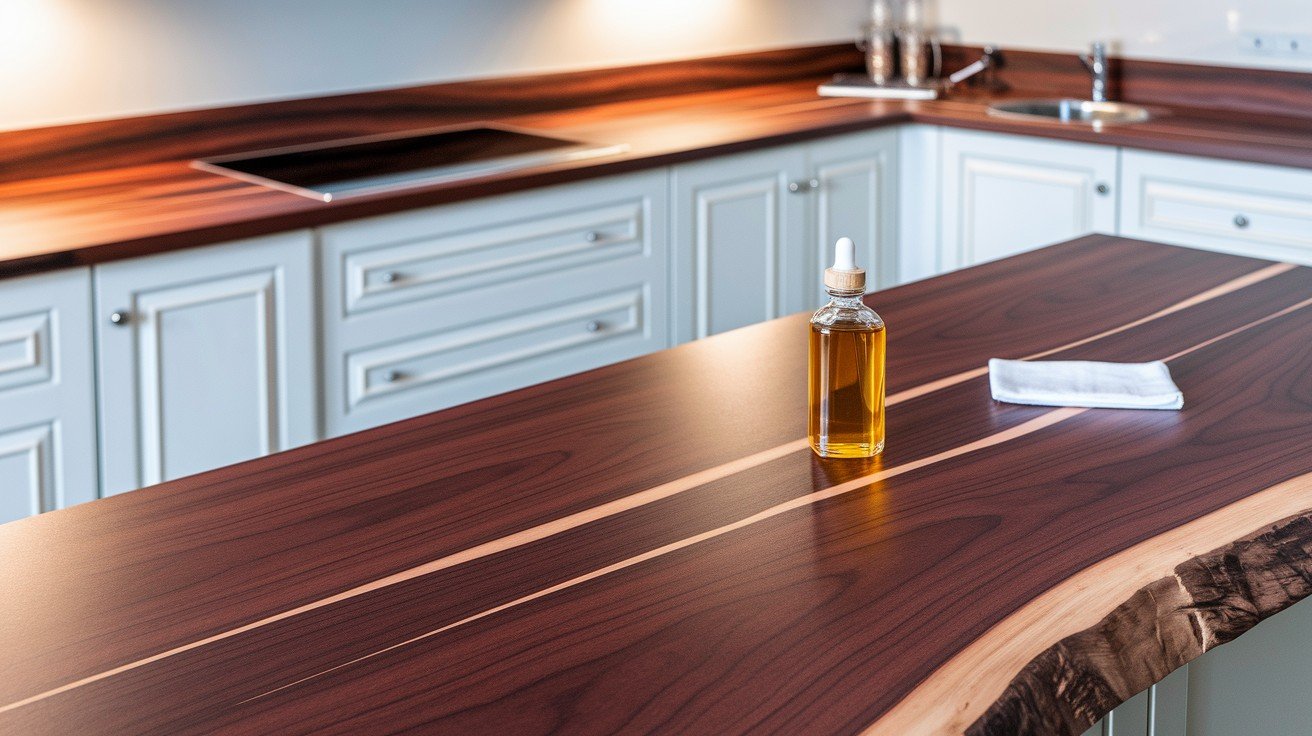
Cherry gets better with age, like a good wine. This wood improves over the years.
Appearance: Rich reddish-brown hues that deepen with age. The new cherry looks nice. Five-year-old Cherry looks beautiful. The color develops into something you can’t get from a stain.
Durability: Most durable hardwood option for countertops. This stuff can handle serious abuse. Restaurant kitchens use cherry because it keeps going when other woods give up.
Cost: $80-$150 per square foot. Yes, it’s expensive. But you’re buying something that lasts decades.
Best For: Creating striking contrast, premium installations. White cabinets with cherry counters? Classic combination that never goes out of style.
Care: Regular oiling to maintain a lustrous finish. Every few months, spend 20 minutes with some food-safe oil. That’s it.
3. Walnut
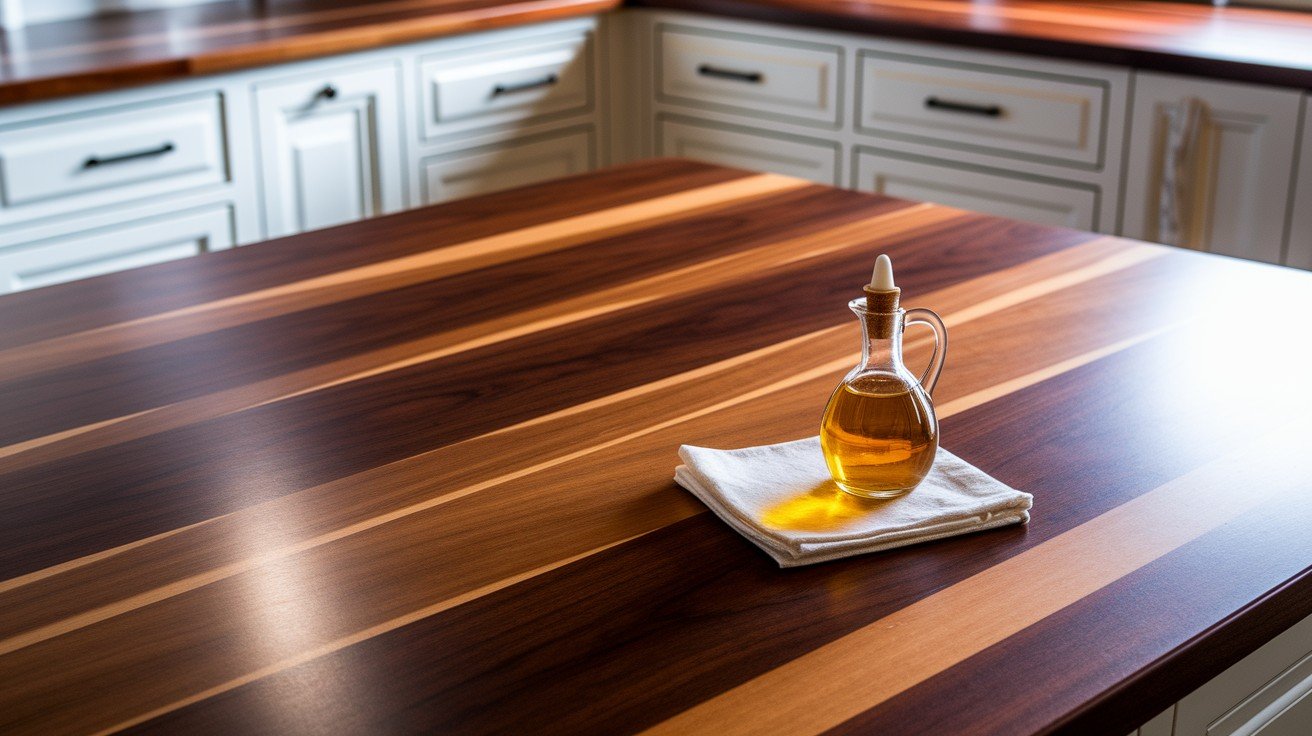
Walnut is the show-off wood. It demands attention and usually gets it.
Appearance: Deep chocolate brown to purplish-black with unique grain. Each piece tells its own story through swirling grain patterns you can’t predict or replicate.
Durability: Impact and scratch resistant. Don’t let the rich looks fool you – walnut is tough as nails underneath all that beauty.
Cost: $70-$130 per square foot. You pay for the drama. But if you want your kitchen to be a conversation starter, this does it.
Best For: Luxury kitchens, refined design contrast. Modern white kitchens come alive with dark walnut counters.
Care: Minimal maintenance, periodic oiling. Walnut is surprisingly low-maintenance for such a high-end look.
4. Oak

Oak is the grandfather of kitchen counters. It’s been doing this job longer than any other wood.
Appearance: Rich grain patterns in red and white varieties. The grain is bold and honest – no pretending to be something it’s not.
Durability: Excellent scratch and dent resistance. Generations of families have cooked on oak. It handles whatever you can dish out.
Cost: $60-$100 per square foot. Fair pricing for proven performance.
Best For: Traditional designs, enhancing resale value. Buyers recognize quality when they see oak. It adds value to your home.
Care: Regular sealing to prevent water damage. Oak is thirsty wood. Keep it sealed and it’ll serve you well.
5. Teak
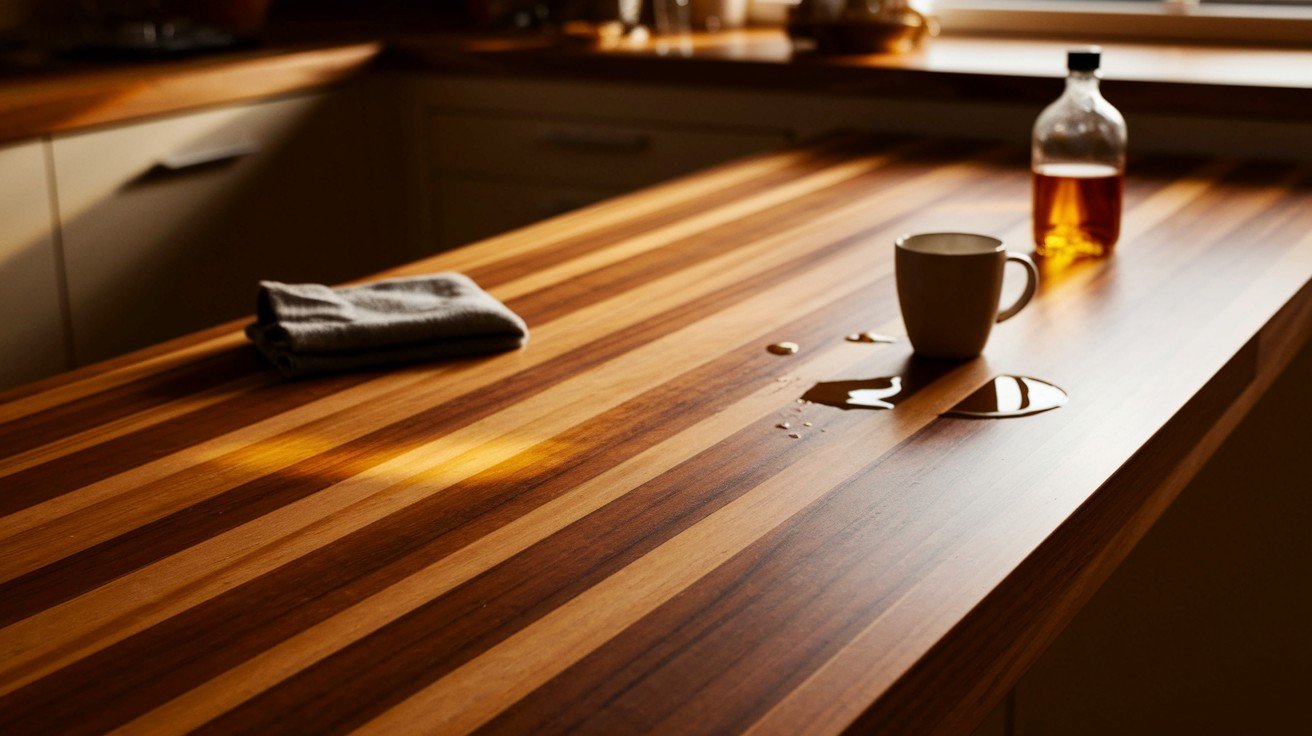
Teak laughs at water damage. This wood grew up in tropical storms.
Appearance: Golden-brown color with straight grain patterns. Clean lines with warm undertones that work in both modern and traditional kitchens.
Durability: Natural water and moisture resistance. Spill your coffee, forget to wipe it up for an hour? Teak shrugs it off.
Cost: Premium pricing for exceptional properties. You pay more upfront but save money on repairs and replacements later.
Best For: High-moisture kitchens, exotic appearance. Got a kitchen that sees lots of water? Teak handles it better than any other wood.
Care: Regular oiling to enhance natural resistance. Even water-resistant wood needs some love. A little oil goes a long way.
6. Acacia
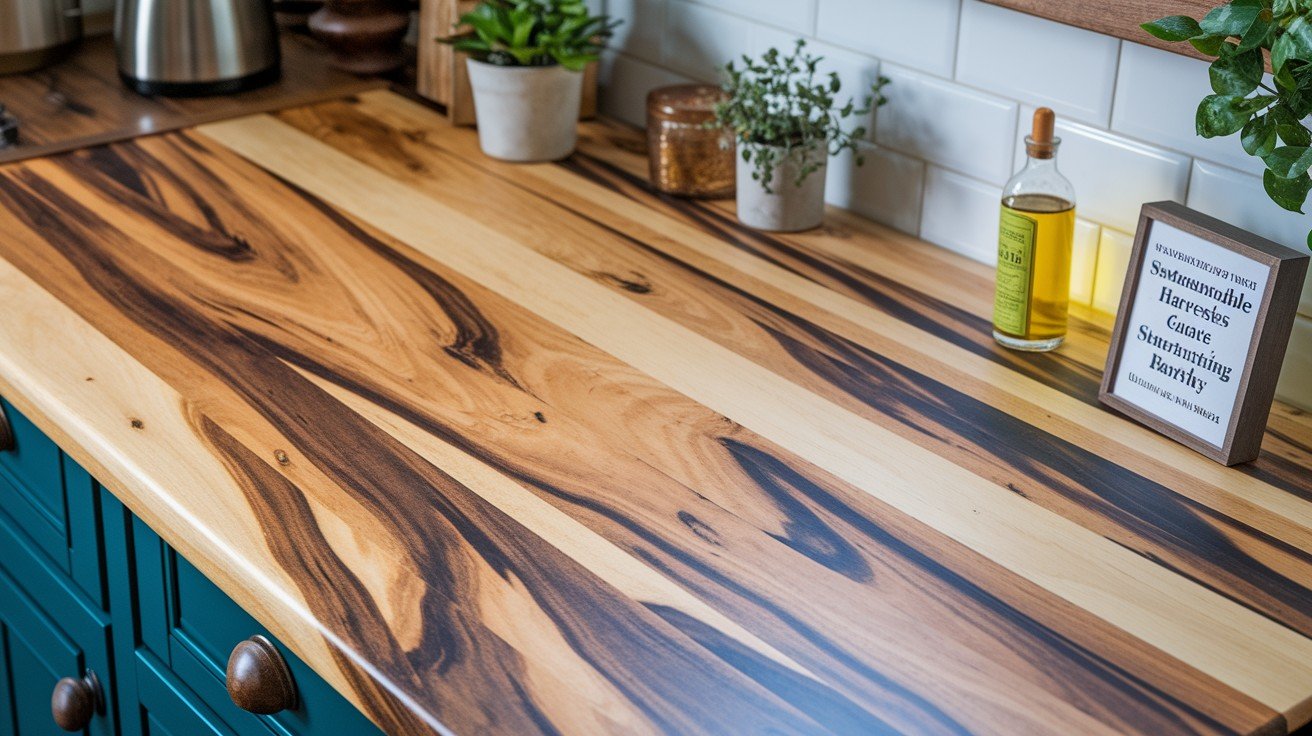
Acacia is the overachiever nobody talks about. It does everything well without making a big fuss.
Appearance: Vibrant grain patterns with varied coloration. Each board looks different – some light, some dark, all interesting.
Durability: Harder than most woods, naturally waterproof. This wood grew up tough. It handles kitchen life without complaining.
Cost: Budget-friendly alternative to premium hardwoods. Great performance without the premium price tag.
Best For: Eco-conscious homeowners, unique grain patterns. Want something different that doesn’t cost a fortune? Acacia delivers.
Care: Regular oiling, sustainable harvesting. Feel good about your choice – acacia trees grow fast and regenerate quickly.
7. Bamboo

Bamboo isn’t technically wood, but it acts like one. And it’s better for the planet.
Appearance: Distinctive tropical look with grass-like patterns. Modern and clean with subtle texture that adds interest without overwhelming.
Durability: Comparable to traditional hardwoods, antibacterial. Natural germ-fighting properties mean safer food prep surfaces.
Cost: Most affordable premium option. Great performance at entry-level pricing.
Best For: Sustainable choice, modern tropical aesthetics. Perfect for eco-conscious homeowners who want style without guilt.
Care: Food-safe sealing, periodic maintenance. A simple care routine keeps bamboo looking fresh for years.
Conclusion
Choosing the right wood for your countertops doesn’t have to be complicated. Each of these 7 wood types offers something different for your kitchen needs.
If you want durability above all else, cherry and teak lead the pack. Budget-conscious? Bamboo and acacia give you quality without the premium price tag. Looking for that luxury feel? Walnut delivers sophistication that’s hard to beat.
Remember, there’s no single “perfect” choice. The best wood for your kitchen depends on how you cook, your design style, and what you’re comfortable spending.
Take your time with this decision. Good wood countertops can last decades with proper care. Consider your daily habits, maintenance preferences, and long-term goals.
Whatever you choose, you’re adding natural beauty and warmth that will make your kitchen a place people want to gather.
Frequently Asked Questions
Which wood type requires the least maintenance for busy kitchens?
Walnut requires minimal maintenance compared to other hardwoods, needing only periodic oiling and basic cleaning routines.
What’s the most budget-friendly wood option that still offers durability?
Bamboo provides excellent durability at the lowest cost, offering sustainability and natural antibacterial properties for value-conscious buyers.
Which wood type works best for kitchens with high moisture?
Teak’s natural oils make it highly water-resistant, making it ideal for kitchens with frequent water exposure.
Can wood countertops handle daily cooking and food preparation safely?
Yes, when properly sealed with food-safe finishes, all recommended hardwoods safely handle daily cooking and preparation.
How long do wood countertops typically last with proper care?
Quality hardwood countertops can last 20-30 years with proper maintenance, often outlasting other countertop materials significantly.

